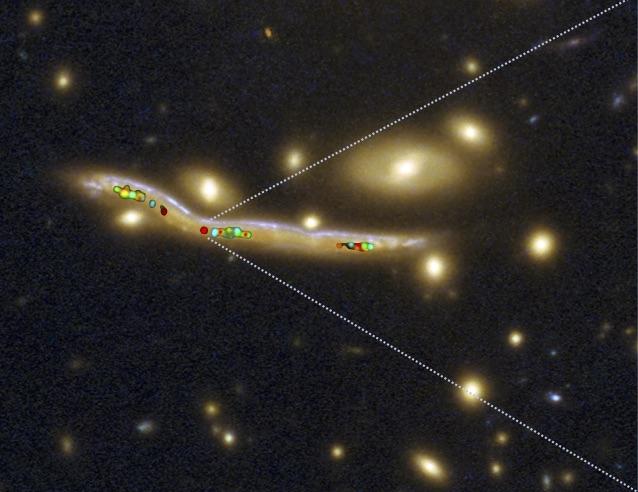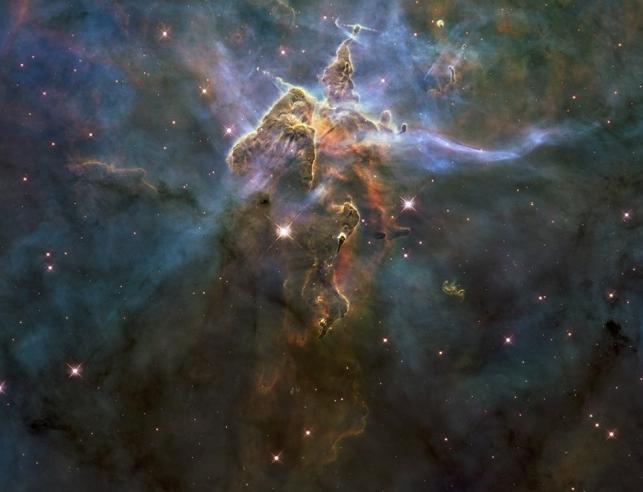Star nurseries in distant galaxies
Star clusters are formed by the condensation of molecular clouds, groups of cold and dense gases found in all galaxies. The physical properties of these clouds in our galaxy or in nearby galaxies have long been known. But are they identical in distant galaxies, more than 8 billion light years away? Thanks to a resolution never before equalled in a distant galaxy, an international team, led by the University of Geneva (UNIGE), and involving four French laboratories including IRAP (University of Toulouse III and CNRS), was able to detect molecular clouds for the first time in a nascent Milky Way. His observations, published in the journal Nature Astronomy, show that these clouds have higher mass, density and internal turbulence than those of nearby galaxies and produce many more stars. Astronomers attribute these differences to the ambient interstellar conditions of distant galaxies, which are too extreme for the survival of molecular clouds typical of nearby galaxies.

Molecular clouds are made of dense and cold molecular hydrogen gas that swirls at supersonic speeds, causing density fluctuations that condense and form stars. In nearby galaxies, such as the Milky Way, a molecular cloud produces between 1000 and 1,000,000,000 stars. Yet in distant galaxies, more than 8 billion light years away, astronomers observe gigantic clusters containing up to 100 times more stars. Why such a difference?
Unequalled observation thanks to a cosmic magnifying glass
To answer this question, astronomers were able to benefit from a natural telescope – the gravitational lens phenomenon – coupled with the use of ALMA (Atacama Large Millimeter/submillimiter Array), an interferometer of 50 millimeter radio antennas that instantly reconstruct the entire image of a galaxy. “Gravitational lenses are a natural telescope that produces a magnifying glass effect by aligning a massive object between the observer and the distant object, explains Johan Richard, astronomer at the Centre de recherche astrophysique de Lyon (CRAL, Université de Lyon Claude Bernard / ENS Lyon / CNRS). Thanks to this effect, we obtain zooms on parts of distant galaxies that we can then study with a resolution of 90 light years that has never been equalled before!” ALMA, on the other hand, measures the level of carbon monoxide that acts as a tracer for the molecular hydrogen gas that makes up the cold cloud.
This resolution made it possible to characterize clouds individually in a distant galaxy, nicknamed the Cosmic Serpent, located 8 billion light years away. “This is the first time we can differentiate molecular clouds from each other,” enthuses Françoise Combes, a researcher at theLaboratoire d’étude du rayonnement et de la matière en astrophysique et atmosphères (LERMA, CNRS / Observatoire de Paris / Université Cergy-Pontoise / Sorbonne Université). Astronomers compared the mass, size, density and internal turbulence between molecular clouds in nearby and distant galaxies. “We thought clouds had the same properties, whatever the époch and galaxies,” continues the Geneva researcher, “but our observations showed the opposite! »

Molecular clouds resistant to extreme environments
Indeed, these early observations revealed that molecular clouds in distant galaxies had a mass, density and turbulence 10 to 100 times higher than those in nearby galaxies. “Such values had only been measured in clouds of nearby colliding galaxies, making their interstellar medium similar to that of distant galaxies,” adds Miroslava Dessauges, a researcher in the Department of Astronomy at the Faculty of Science of the UNIGE and the study’s first author. The researchers have thus linked these differences in the physical properties of clouds to the environments of galaxies, which are more extreme and hostile in distant galaxies than those of their close sisters: “a molecular cloud of a nearby galaxy would instantly collapse and be destroyed in the interstellar medium of distant galaxies, hence its properties multiplied to guarantee its survival and balance”, explains the Geneva researcher. “Chance or not, the characteristic mass of the molecular clouds of the Cosmic Serpent appears to be in perfect agreement with our scenario of fragmentation of turbulent galactic discs, proposed as a mechanism for the formation of massive molecular clouds in distant galaxies,” says Lucio Mayer, Professor at the Centre for Physical and Cosmological Theory at the University of Zurich.
The international team also discovered that the star formation efficiency level of the molecular clouds of the Cosmic Serpent is particularly high, favored by the high internal turbulence of the clouds. “In nearby galaxies, a cloud forms stars about 5% of its mass. In distant galaxies, this figure rises to 30%,” observes Daniel Schaerer, professor in the Department of Astronomy at the Faculty of Science of the UNIGE.
Astronomers will now study other distant galaxies to confirm their observations of the Cosmic Serpent. “We will also take the resolution even further by taking advantage of the unique performance of the ALMA interferometer and investigate in more detail this ability of molecular clouds observed in distant galaxies to form stars so effectively,” concludes Miroslava Dessauges.
Further Resources
- Scientific article : Miroslava Dessauges-Zavadsky, Johan Richard, Françoise Combes, Daniel Schaerer, Wiphu Rujopakarn, Lucio Mayer, Antonio Cava, Frédéric Boone, Eiichi Egami, Jean-Paul Kneib, Pablo G. Pérez-González, Daniel Pfenniger, Tim D. Rawle, Romain Teyssier & Paul P. van der Werf. Molecular clouds in the Cosmic Snake normal star-forming galaxy 8 billion years ago Nature Astronomy (2019) https://doi.org/10.1038/s41550-019-0874-0
- Laboratories involved : Le Centre de recherche astrophysique de Lyon (CRAL, Université de Lyon Claude Bernard / ENS Lyon / CNRS), le Laboratoire d’étude du rayonnement et de la matière en astrophysique et atmosphères (LERMA, CNRS / Observatoire de Paris / Université Cergy-Pontoise / Sorbonne Université), l’Institut de recherche en astrophysique et planétologie (IRAP, Université Toulouse Paul Sabatier / CNRS / CNES) et le Laboratoire d’Astrophysique de Marseille (LAM, Aix-Marseille Université / CNES / CNRS)
IRAP Contact
- Frédéric Boone, frederic.boone@irap.omp.eu






